

CARDIOVASCULAR JOURNAL OF AFRICA • Volume 30, No 3, May/June 2019
162
AFRICA
Delayed angioplasty is superior to an emergency
strategy in ST-segment elevation myocardial infarction
patients who present late and with infarct artery
spontaneous reperfusion before intervention
Mingxing Li, Zidi Wu, Yong Yuan, Li Feng, Yi Lao, Zhigang Guo
Abstract
Objective:
The best time to perform percutaneous coronary
intervention (PCI) in ST-segment elevation myocardial infarc-
tion (STEMI) patients presenting 12 to 72 hours after chest
pain is unclear. The aim of this study was to explore whether
delayed PCI was superior to emergency PCI in STEMI patients
who presented 12 to 72 hours after onset of symptoms and
with a spontaneous reperfusion infarct-related artery (IRA).
Methods:
STEMI patients who presented 12 to 72 hours
after symptom onset were enrolled and assigned to either the
emergency PCI or delayed PCI group. We compared the rates
of procedural success and in-hospital mortality as well as the
main adverse cardiac events (MACE) during hospitalisation
and after one year of follow up.
Results:
We enrolled 159 patients in this retrospective study.
Emergency PCI was performed in 73 patients and delayed
PCI in 86 patients. A remarkably high rate of procedural
success was achieved in the delayed PCI group compared
with the emergency PCI group (97.7 vs 86.3%,
p
=
0.007) due
to a lower rate of no re-flow or slow flow (2.3 vs 13.7%,
p
=
0.007). There was no significant difference in terms of MACE
and in-hospital mortality rates (16.4 vs 9.3%,
p
=
0.133; 1.4
vs 2.3%,
p
=
0.562). During one year of follow up, the left
ventricular ejection fraction was similar in the two groups
[median 58% (57–68) in the emergency PCI group vs median
56% (50–62) in the delayed PCI group,
p
=
0.666]. Although
the emergency PCI group had a trend towards a higher rate of
MACE, the difference was not statistically significant (12.2 vs
11.6%, HR
=
1.067, 95% CI: 0.434–2.627,
p
=
0. 887).
Conclusion:
In STEMI patients who presented late (12–72
hours) after symptom onset and with a spontaneous reperfu-
sion IRA, delayed PCI showed a higher rate of procedural
success without increased rates of in-hospital and long-term
MACE and mortality.
Keywords:
ST-segment elevation myocardial infarction, angio-
plasty, TIMI flow, timing, spontaneous reperfusion
Submitted 16/8/17, accepted 25/1/19
Published online 16/5/19
Cardiovasc J Afr
2019;
30
: 162–167
www.cvja.co.zaDOI: 10.5830/CVJA-2019-009
Treatment of patients with ST-segment elevation myocardial
infarction (STEMI) has substantially evolved over the past 10
years, due to improvement in pharmacological and mechanical
reperfusion strategies.
1
Current clinical practice, however,
includes a high proportion of patients presenting late after onset
of symptoms.
2-6
STEMI patients who present late would be outside of the
‘golden time window’ for reperfusion and are expected to exhibit
less myocardial salvage, an expansion of infarct size, as well as
a higher mortality rate when compared with early comers.
7-10
A
growing body of evidence has shown that STEMI patients who
present late but with a patent infarct-related artery (IRA) tend
to have a better prognosis,
11,12
and benefit from percutaneous
coronary intervention (PCI).
13,14
What remains unknown is the
exact time window during which late reperfusion can still provide
the best prognosis as well as the lowest related risk. The aim of
this study was to explore whether delayed PCI (performed more
than 24 hours after admission) was superior to emergency PCI
(performed within two hours of admission) in STEMI patients
who presented 12 to 72 hours after symptom onset and with a
spontaneous reperfusion IRA (TIMI flow grade of 2 to 3).
Methods
The population consisted of STEMI patients treated with
percutaneous coronary intervention at our institute from 1
January 2008 to 1 January 2015. The local ethics committee
approved the study.
Inclusion criteria were: STEMI patients who were admitted
after more than 12 but within 72 hours of the onset of symptoms;
an IRA TIMI flow grade of 2 to 3 during initial angiography;
and PCI performed during hospitalisation. The major exclusion
criteria were: the time from the onset of symptoms to admission
was 12 hours or less, or more than 72 hours; the IRA TIMI flow
grade was 0 to 1; patients suffered from cardiogenic shock or
electrical instability, or chest pain persisted when admitted; PCI
was not performed during hospitalisation.
The emergency PCI group was defined as PCI performed
within two hours of admission. The delayed PCI group was
Division of Cardiology, Huiqiao Medical Centre, Nanfang
Hospital, Southern Medical University, Guangzhou,
Guangdong, China
Mingxing Li, MD
Zhigang Guo, MD,
18218515726@163.comDepartment of Cardiology, Zhongshan People’s Hospital,
Zhongshan City, Guangdong, China
Mingxing Li, MD
Zidi Wu, MD
Yong Yuan, MD
Li Feng, MD
Yi Lao, MD

















